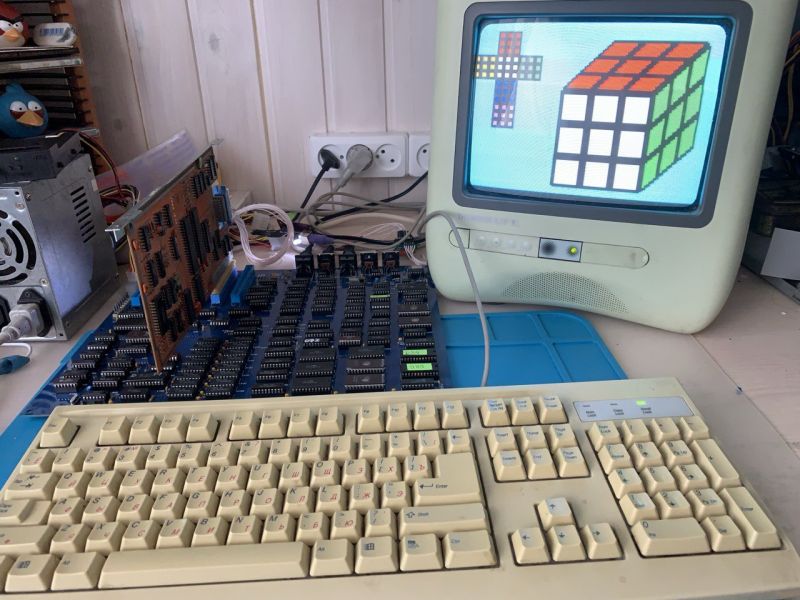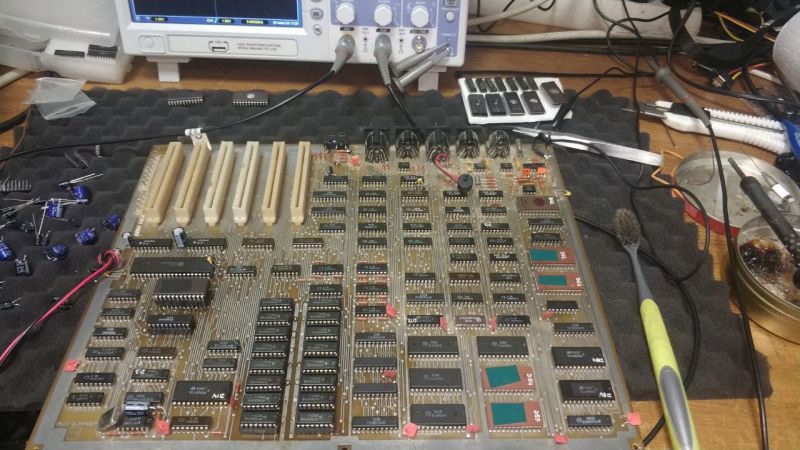In one of the topics on our forum, not at all about computers, more about automobiles, a question was asked about Soviet hardware. At the time it was about the Agat, which many people thought was a clone of the American Apple II. Unfortunately, when I lived in the Soviet Union, I didn't have the opportunity to interact with this equipment, as it went into schools when I was past high school graduation. I later entered university in Poland. From there I returned to a completely different country - to independent Russia, when the Agat had become obsolete and other machines were popular (I had the Vektor-06C, Apogej, Junior, Poisk).
.
However, the subject of the Agat has sparked interest in our forum and I decided to look into its history of creation and other details. Over the course of a few days, I gathered information and even contacted one of the early users and enthusiasts of this equipment. Vladimir, for that is his name, told me interesting things and gave me some sources based on which this material was prepared.
The creation of the Soviet Agat computer
Outside the former USSR, the Agat is well-known thanks to its publication in a magazine popular even in Poland: "Byte". The article appeared in November 1984 under the title: "AGAT: A Soviet Apple II Computer - The Russians first microcomputer is a bad copy of the Apple". The author was Leo D. Bores, an American who had visited the Fyodorov Eye Microsurgery Complex in Moscow. I have translated this material into Polish. But I will publish it later.
It is interesting that, despite the high-profile title apparently given by the magazine's editors, the author gave a quite positive assessment of this strange equipment from the point of view of a Western professional.
According to Wladimir, the American was dealing with the original version of the computer, which seriously differed from the serial one and even more so from the next developmental ones.
Despite speculation to the contrary, the Agat was not a failed clone of the Apple II or the Bulgarian Prawec. Vladimir explains that it was not intended to duplicate the aforementioned hardware at all. Initially, the management of the computer development organisation in the USSR could not make up their minds, choosing between devices with Intel or DEC architecture. In the end, they got their hands on 10 Apple II computers. These provided a model of sorts, but at the same time they were radically redesigned. The solutions used in the original helped to reduce production costs, because there was fierce competition in the areas where the whole thing was manufactured. In the Soviet Union, no one cared, because the Agat, firstly, was not intended to be sold on the free market, and secondly, there would be no one to compete with. In this country, no one cared much about price. Therefore, and for reasons described a little below, the Soviet version of the serial machine had some advantages. Among them:
1. Flexible and multi-page displey controller, with true colours and no attribute conflicts;
2. Full-featured Character and colour generator for text modes;
3. Successful segmented memory architecture;
4. Fast disk controller and advanced disk subsystem.
The purpose of the Agat computer and the unusual way in which its production was financed
The history of the development of this hardware is linked to bizarre, from the point of view of the modern economy, factors. The large number of models was due not to market demand, but to a system of funding and incentives for companies to produce a computer for general use. That is, the number of versions of the device was rather artificial and allowed to demonstrate: 'performance' in the development of production and thus attract support and resources.
This is also followed by the strange nature of determining the price of this production. The Agate was originally intended for teaching purposes. It could therefore not be sold directly to private individuals. The myth of the high price is related to this.
Let me remind you that in the USSR, in addition to the ruble for the citizen, there was another means of transaction, for settlements between enterprises. Its value had little to do with cash and even less with the ruble in currency. The announced price of the Agat took into account its value precisely in these units of settlement and was 3900 roubles (for state organisations only). While one of the first personal computers BK0010 (БК0010) cost 700 roubles (without a monitor) and was sold on the general market.
Characteristics of the various versions produced .
Almost 10 models were produced in total, despite speculation that there were more. This is due to the modular design, which could be changed at any time by including new options. The best-known next versions are:
* Agat-1/2/3 (1980-83) - prototypes that received a digital designation (for an official demonstration at the ministry that was deciding whether to start production at the state-owned plant). Several more did not receive this designation - they were called: "Agate fifth model", "Agate red", etc. This period saw the transition from early machines being Russified Apple clones (the motherboard is an exact copy of the Apple II, the integrated circuits are analogues of the imported ones) to true Agates.
* Red Agate (1983): handmade metal case. It was essentially a prototype.
* Agat-4 (1984): experimental batch of 100 machines with architecture similar to the Agat-7.
* Agat-7 (1985-90): RAM - 96 kb (up to 640 kb), disk drive - 140 kb (early versions) or 840 kb (later versions), serial and parallel interface module.
* Agat-8 was similar to the Agat-7, but with a printer included.. Sometimes with increased base RAM and an extended character generator.
* Agat-9 (1988-93): RAM - 128 kb (up to 640 kb), disk drive - 840 kb (sometimes supplemented by a second 140 kb drive), printer controller, Apple II emulation capability.
* Gold Agate (1985): special version of the seven for the Ministry of Defence.
Setup of US and Soviet equivalent hardware
So let's compare the Apple II and the Agat. At first glance you can see the differences in the design of these computers. The Agat has a more contemporary design with a disk drive in the case.
The motherboard is also quite different from that of the Apple II or Prawec.
As for the drive stations, originally there were in fact drives similar to the Apple of Bulgarian manufacture used. However, this was not intentional. The problem was that they wanted to use a drive from the Japanese company TEAC with electronics developed by the manufacturer Agat with a capacity of 840 kb. However, delivery was late. Therefore, for the first batch, ЕС5088 drive stations, already adapted to work with the 6502 processor, were purchased. In these versions, the interaction with the drive was the same as in the original Apple - that is, the CPU fulfilled a large part of the controller's work.
As for memory, the standard Agat had the option of detaching the ROM and connecting the RAM in ROM mode. Apple for this offered a separate card: "Language Card", which had some limitations.
Apple's monitor controller had two memory banks with specific RAM addresses. Agat had any number of these, using any RAM address as video memory. Apple did not have the ability to use colours in text mode, whereas Agat in 32x32 character mode could display them in sixteen.
The graphic capabilities of the Apple (screen resolution 280х192 pixels, black and white or 140х192 pixels, 6 colours) and the Agat (512х256 pixels, black and white or 256х256, colour) were more or less similar. However, their implementation was easier in Soviet hardware. Apple's problem was that it was designed to work with televisions with an NTSC decoder. In this standard, the selection depends on the position and colour of adjacent pixels on the screen. Agat worked with colour televisions of the SECAM standard, where these drawbacks did not exist.
Because of the difference in hardware, the creators of the Agat didn't much care for software from Apple, especially as this computer was oriented towards Soviet universities and American soft didn't quite fit. So they developed a huge amount of their own, which did not run on the original Apple II.
Summary .
The Agat was not a bad or good copy of Apple, but a separate computer, albeit modelled on a counterpart from the States. According to Vladimir, it was a success. However, I would not say that. The Agat was produced in a run of a few thousand units, while the Apple II was in the several million range.
.
Contemporary Agat-9 motherboard developed by enthusiasts of this computer. Photo: Grigory Gaevyy.
However, the subject of the Agat has sparked interest in our forum and I decided to look into its history of creation and other details. Over the course of a few days, I gathered information and even contacted one of the early users and enthusiasts of this equipment. Vladimir, for that is his name, told me interesting things and gave me some sources based on which this material was prepared.
The creation of the Soviet Agat computer
Outside the former USSR, the Agat is well-known thanks to its publication in a magazine popular even in Poland: "Byte". The article appeared in November 1984 under the title: "AGAT: A Soviet Apple II Computer - The Russians first microcomputer is a bad copy of the Apple". The author was Leo D. Bores, an American who had visited the Fyodorov Eye Microsurgery Complex in Moscow. I have translated this material into Polish. But I will publish it later.
It is interesting that, despite the high-profile title apparently given by the magazine's editors, the author gave a quite positive assessment of this strange equipment from the point of view of a Western professional.
According to Wladimir, the American was dealing with the original version of the computer, which seriously differed from the serial one and even more so from the next developmental ones.
Despite speculation to the contrary, the Agat was not a failed clone of the Apple II or the Bulgarian Prawec. Vladimir explains that it was not intended to duplicate the aforementioned hardware at all. Initially, the management of the computer development organisation in the USSR could not make up their minds, choosing between devices with Intel or DEC architecture. In the end, they got their hands on 10 Apple II computers. These provided a model of sorts, but at the same time they were radically redesigned. The solutions used in the original helped to reduce production costs, because there was fierce competition in the areas where the whole thing was manufactured. In the Soviet Union, no one cared, because the Agat, firstly, was not intended to be sold on the free market, and secondly, there would be no one to compete with. In this country, no one cared much about price. Therefore, and for reasons described a little below, the Soviet version of the serial machine had some advantages. Among them:
1. Flexible and multi-page displey controller, with true colours and no attribute conflicts;
2. Full-featured Character and colour generator for text modes;
3. Successful segmented memory architecture;
4. Fast disk controller and advanced disk subsystem.
The purpose of the Agat computer and the unusual way in which its production was financed
The history of the development of this hardware is linked to bizarre, from the point of view of the modern economy, factors. The large number of models was due not to market demand, but to a system of funding and incentives for companies to produce a computer for general use. That is, the number of versions of the device was rather artificial and allowed to demonstrate: 'performance' in the development of production and thus attract support and resources.
This is also followed by the strange nature of determining the price of this production. The Agate was originally intended for teaching purposes. It could therefore not be sold directly to private individuals. The myth of the high price is related to this.
Let me remind you that in the USSR, in addition to the ruble for the citizen, there was another means of transaction, for settlements between enterprises. Its value had little to do with cash and even less with the ruble in currency. The announced price of the Agat took into account its value precisely in these units of settlement and was 3900 roubles (for state organisations only). While one of the first personal computers BK0010 (БК0010) cost 700 roubles (without a monitor) and was sold on the general market.
Characteristics of the various versions produced .
Almost 10 models were produced in total, despite speculation that there were more. This is due to the modular design, which could be changed at any time by including new options. The best-known next versions are:
* Agat-1/2/3 (1980-83) - prototypes that received a digital designation (for an official demonstration at the ministry that was deciding whether to start production at the state-owned plant). Several more did not receive this designation - they were called: "Agate fifth model", "Agate red", etc. This period saw the transition from early machines being Russified Apple clones (the motherboard is an exact copy of the Apple II, the integrated circuits are analogues of the imported ones) to true Agates.
* Red Agate (1983): handmade metal case. It was essentially a prototype.
* Agat-4 (1984): experimental batch of 100 machines with architecture similar to the Agat-7.
* Agat-7 (1985-90): RAM - 96 kb (up to 640 kb), disk drive - 140 kb (early versions) or 840 kb (later versions), serial and parallel interface module.
* Agat-8 was similar to the Agat-7, but with a printer included.. Sometimes with increased base RAM and an extended character generator.
* Agat-9 (1988-93): RAM - 128 kb (up to 640 kb), disk drive - 840 kb (sometimes supplemented by a second 140 kb drive), printer controller, Apple II emulation capability.
* Gold Agate (1985): special version of the seven for the Ministry of Defence.
Setup of US and Soviet equivalent hardware
So let's compare the Apple II and the Agat. At first glance you can see the differences in the design of these computers. The Agat has a more contemporary design with a disk drive in the case.
Photo: Jeeno Laretti.
.
The motherboard is also quite different from that of the Apple II or Prawec.
As for the drive stations, originally there were in fact drives similar to the Apple of Bulgarian manufacture used. However, this was not intentional. The problem was that they wanted to use a drive from the Japanese company TEAC with electronics developed by the manufacturer Agat with a capacity of 840 kb. However, delivery was late. Therefore, for the first batch, ЕС5088 drive stations, already adapted to work with the 6502 processor, were purchased. In these versions, the interaction with the drive was the same as in the original Apple - that is, the CPU fulfilled a large part of the controller's work.
As for memory, the standard Agat had the option of detaching the ROM and connecting the RAM in ROM mode. Apple for this offered a separate card: "Language Card", which had some limitations.
Apple's monitor controller had two memory banks with specific RAM addresses. Agat had any number of these, using any RAM address as video memory. Apple did not have the ability to use colours in text mode, whereas Agat in 32x32 character mode could display them in sixteen.
The graphic capabilities of the Apple (screen resolution 280х192 pixels, black and white or 140х192 pixels, 6 colours) and the Agat (512х256 pixels, black and white or 256х256, colour) were more or less similar. However, their implementation was easier in Soviet hardware. Apple's problem was that it was designed to work with televisions with an NTSC decoder. In this standard, the selection depends on the position and colour of adjacent pixels on the screen. Agat worked with colour televisions of the SECAM standard, where these drawbacks did not exist.
Agat's graphic capabilities. Photo: Grigory Gaevyy.
Because of the difference in hardware, the creators of the Agat didn't much care for software from Apple, especially as this computer was oriented towards Soviet universities and American soft didn't quite fit. So they developed a huge amount of their own, which did not run on the original Apple II.
Summary .
The Agat was not a bad or good copy of Apple, but a separate computer, albeit modelled on a counterpart from the States. According to Vladimir, it was a success. However, I would not say that. The Agat was produced in a run of a few thousand units, while the Apple II was in the several million range.
Cool? Ranking DIY










